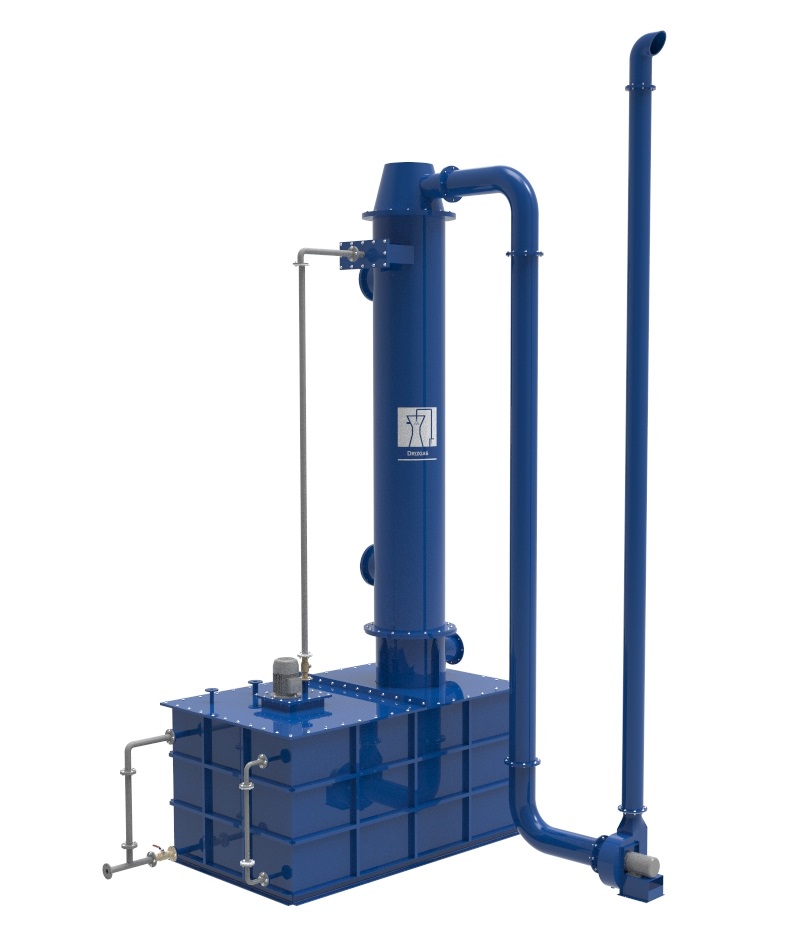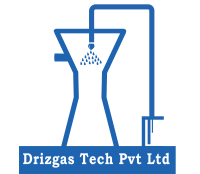Explanation
- Nitric acid is one of the most common mineral acids in the chemical Industry. It is produced by a high temperature oxidation of ammonia with oxygen catalyzed by a platinum/rhodium contact.
- This results in a nitric acid/water mixture with a strength of up to almost 68 wt% nitric acid. The majority of nitric acid is used for the production of fertilizers.
- Other processes such as the production of explosives, pigments, rocket fuels or polyurethanes require higher concentrated nitric acid.
Features
- Air flow rate from 50 to 30000 CFM
- Material of construction: PP, PP+FRP, MS, SS 304, SS 316
- Scrubbing efficiency up to 99 %Lower shell serves as integral sump for recycle of liquid
- Spray nozzles accessible from top of unit
- Entrainment separators prevent liquid carryover
- Special multi-bed packing designs accommodate different scrubbing solutions for removal of multiple contaminants

Mechanism
Nitric acid scrubber
Nitric acid
Nitrogen oxides are major pollutants in the atmosphere, being a precursor to acid rain, photochemical smog, and ozone accumulation. The oxides are mainly nitric oxide (NOx) and nitrogen dioxide (NO2) both of which are corrosive and hazardous to health. With the use of catalytic converters, the focus of controlling of NOx emissions has become economically impractical. Consequently, the stationary sources of NOx emissions are now being subjected to more stringent standards in many countries. The sources include nitric acid manufacturing plants, manufacturers of nitrated materials such as fertilizer and explosives, and industrial manufacturers, metallurgical processors, glass manufacturers, cement kilns and power generator where high processing temperatures are used. Because of the environmental concerns posed by air pollution, it is important to design and implement scrubber system for controlling NOx emissions.
Nitrogen Oxide Sources
- Combustion of fuels: At high temperatures, oxygen and nitrogen present in air combine to form nitrogen oxides. Typical flue gas samples contain 100-1500 ppm of nitrogen oxides.
- Nitric acid manufacture: Waste gases which cannot be economically recovered in the final absorber usually contain 2-3% nitrogen oxides based on weight of acid produced.
- Metal finishing operations: Many metal surface treatment operations which use nitrates, nitrites, or nitric acid which evolve nitrogen oxides.
- Chemical processes: Many processes where nitric acid, nitrates, or nitrites are used as reagents evolve nitrogen oxides. Examples include manufacture of explosives, plastics, dyes, etc.
- High temperature processes: Processes where materials are made at high temperatures such as glass manufacturing, electric furnaces, and cement kilns evolve nitrogen oxides.
- “Breathing” of the tank during changes in ambient temperatures, resulting in very low rates of emissions.
- Tank filling that displaces gaseous volumes equal to the volumes flowing into the storage tank.
Exposure limits
Long term inhalation exposures to nitric acid can cause chronic respiratory irritation, which may result in chronic bronchitis and airways hyper-reactivity. Repeated exposure to nitric acid vapours, mists or aerosols may cause dental erosion. As nitric acid is inhaled, it may be deposited on teeth and cause decalcification resulting in erosion of tooth enamel.
OSHA: The legal airborne permissible exposure limit (PEL) : 2 ppm (8 hour average)
NIOSH: The recommended airborne exposure limit (REL): 2 ppm (10 hour average)
ACGIH: The threshold limit value (TLV): 2 ppm
ACGIH: Short time exposure limit (STEL): 4 ppm
Highlights
- Scrubbing nitric acid (HNO3 ) is very similar to scrubbing HCl. Not only are the methods the same, but there is also good potential for recovering aqueous HNO3 in a usable form in those applications in which high concentrations exist in the gas stream and other contaminants are not present that might contaminate the product. However, in some processes that produce HNO3, nitrogen oxides (NOx) are also produced.
- The effective scrubbing of NOx is much more complicated than acid gas scrubbing. It depends greatly upon which species is present, if mixed species are present (which often occurs), at what absolute levels they exist, and at what relative levels they exist. Nonconventional and special proprietary methods of scrubbing are often required.
- One key to properly determining the design of the treatment equipment is the type of filling operation that occurs. If the storage tank is filled using a mechanical pump, then the design capacity of the treatment equipment (scrubber) is simply equivalent to the volume of the displaced gas as the tank is being filled.
- The concentration of acidic gases is directly related to the vapor pressure of the acid in aqueous solution. However, it is also related to the pressure of the gas space above the stored liquid. This then differs between the gas stream simply exiting the atmospheric storage tank or the gas resulting from the surge gas coming from a pressurized source. This is another factor to be carefully examined and accounted for.
Mechanism
The process entails injecting H2O2 into the absorber feed water to provide a dilute solution containing 0.5 – 1 wt.% H2O2. This solution is passed through the absorber where NOx constituents are transferred from the vapor into the solution and oxidized to high-grade HNO3. The oxidation reactions are rapid at moderate temperatures (30-80 degrees C), with about 1.7 and 0.4 lbs H2O2 required per lb of NO and NO2, respectively.
The chemistry controlling the process
3NO2 + H2O → 2HNO3 + NO
2NO + HNO3 + H2O → 3HNO2
HNO2 + H2O2 → HNO3 + H2O
Drizgas Tech provides the complete scope of services for fume ventilation and scrubbing systems including the following:
- Engineering & Design
- Fume Scrubber Fabrication
- Custom Hoods & Enclosures
- Complete Ventilation Systems
- Makeup Air Systems
- System Installation & Start-up
- System Upgrades & Repairs
- Airflow Measurements & Balancing
- Preventative Maintenance Programs
Applications
- Steel industries exhaust scrubbing
- Fireworks industries
- Crackers chemical emission scrubbing
- Food manufacturing industries exhaust scrubbing
- Coal industries exhaust scrubbing
- Chemical factory wet scrubbing
- Reactor vent scrubbing
- Process vent scrubbing
- Acid Plating emission scrubbing
- Acid etching emission scrubbing
- Storage room exhaust scrubbing
